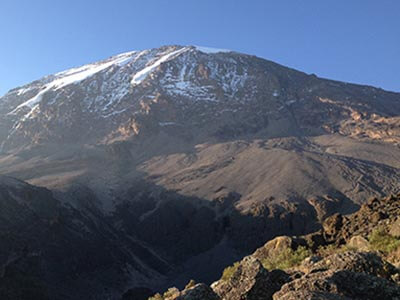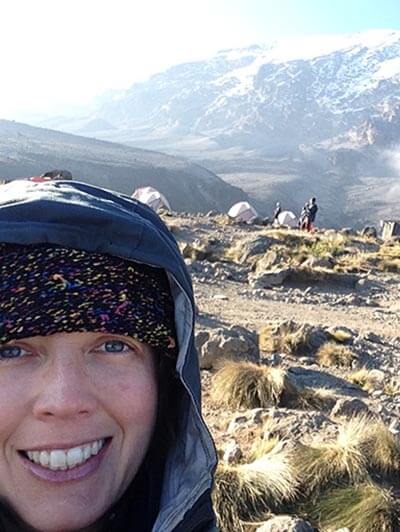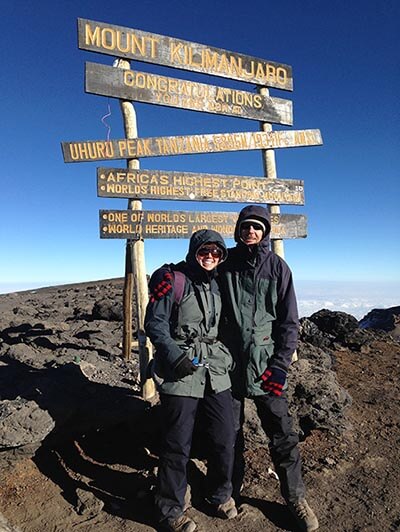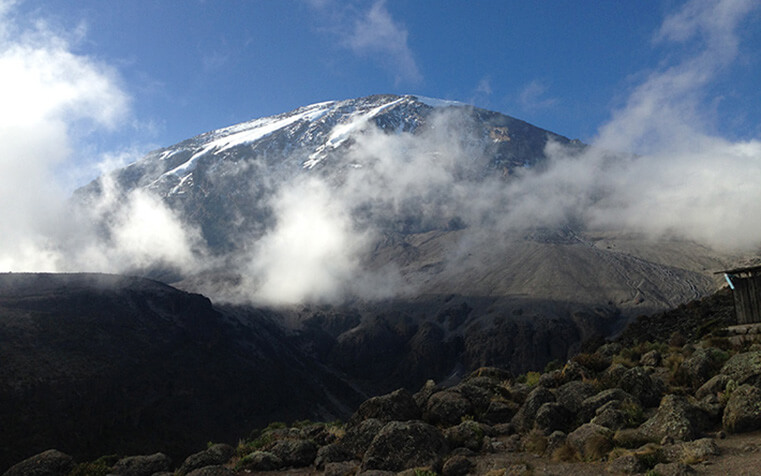I’ll admit it straight up, I had many anxieties in the months prior to climbing “Kili”. I had heard a few stories from friends and past climbers about the challenging conditions, the disappointment of not summiting and the health hazards of high altitude.
A month or so before we left for this trip I actually questioned why we were doing it and dreamt of skipping it for some extra time on the way home in the Maldives after our month of travel in Africa. After having this trek on our “bucket list” for some 5 years, we were finally going to do it. But I had become reluctant – all because I listened to those who had been before us – what a mistake that was.
Once we had been briefed by our tour representative, in Moshi Tanzania the day before our trek began, I realised that it wasn’t a peak to fear, but one to conquer.
We had chosen the 7 day trek which meant we spent 6 nights/7 days on the mountain instead of the usual 5 nights/6 days. The extra day and night would assist with acclimatisation and by choosing the Machame Route, we experienced more amazing views and scenery despite the extra challenge of summit attempt and a couple of rock scrambles along the way, which actually, dare I say it, made it more fun.
We had a small group, only 3 of us trekkers and 14 crew members that was made up of Head Guides, Cook, Cook Assistant, Waiter and Porters. Our crew were a cheery bunch of Tanzanians who loved to sing and perform welcome and farewell dances and often trekked back to back tours during the busy season (January to mid-March and June to Oct).
Day 1 of our trek involved a 9am pick up from our hotel and transfer to the Machame Gate where we collected our packed lunches and waited for the final permits, paperwork and weighing of the gear and equipment to ensure enough porters were employed and bag weights were under the maximum limit. Around lunchtime (after one last flush toilet experience) we headed off on our first day of walking. There were at least 100 trekkers setting off that day, plus all the porters and crew with different trekking companies. The track was very busy as we set off uphill through lush rainforest, letting the sweating porters pass us so they could reach camp first and set up. The pace they kept was intense and they carried huge packs containing trekkers packs, tents and camping equipment up to 15kg and even gas bottles required for cooking.
Our first camp was called Machame Camp and sitting at around 2800m, we climbed 1000m in altitude that day taking around 4-5 hours. It was humid and sweaty but the climb was gradual and we took our time, stopping for lunch and rest stops. Once at camp we were offered warm water in a bowl for hand/face washing and our tents and mattresses were already set up for us. A mess tent was set up, a hot water thermos for tea and coffee and a big bowl of popcorn with camp chairs and a folding table appeared. Suddenly the guilt set in as I thought of the porter who carried these up the hill for our comfort when the crew sat in tents on the floor to keep out of the cooling weather. And then dinner arrived, hot soup followed by main course of rice and vegetable casserole and sliced fresh fruit for dessert (more guilt!). Our day had been dominated by more food than walking but we were assured by our guides that eating lots now would mean having energy for when it got tougher. We didn’t argue.
The campsite was crowded that night with tents and with disrupted sleep (some people forget you can hear everything through a tent wall), we rested that night until sunrise for our 7am wakeup call.

A big breakfast of porridge, eggs, toast and fruit meant we were loaded for an uphill climb to our next stop, Shira Camp. The landscape changed from rainforest to sub-alpine and our climb became rockier and more exposed but with so much thick cloud surrounding us and drizzly rain, we could not see much until lunchtime. The weather changes so fast, just while we sat for lunch in the rain, the clouds suddenly parted and sun appeared showing Kibo, the main peak – we suddenly for the first time had our bearings and could see what we were aiming for. Our moods lifted. We reached our camp by early afternoon at 3600m. We noticed lower oxygen levels at this exposed site where it was windy and dusty – some of us had headaches, others were fine. We settled in and had a short acclimatisation walk to Shira Cave later that day and climbed a little higher on a nearby rise which overlooked the camp.
Sleeping was a bit harder here. The lower oxygen levels affect your breathing rhythm and I found I couldn’t sleep deeply or for lengthy periods and my dreams (when I dozed) could have been Hollywood’s next blockbuster. It was a relief to get up and start the day after laying awake for most of the night. Day 3 was to be a real test. From 3600m we were to climb to Lava Tower for lunch at 4600m and then down to 3600m to Baranco Camp for the night, a full day of walking.
Our walking pace was difficult to describe. To some, it would be laughable, but to us, it worked and was strictly paced by our guides. We felt we were barely moving at times and you had to concentrate hard on breathing deeply but to go faster could mean more issues with acclimatising to the higher altitude so we plodded on.
We were so lucky with good weather. It started out windy but became sunny and clear. We enjoyed great views while walking and the lunch spot at Lava Towers was so comfy and warm – we could have almost laid in the sun for a nap. We had packed extra clothing in case it was -5 degrees as the Lava Towers lunch site is known for that on a bad day, but we were just grateful for the sun. We were all coping OK at 4600m despite breathing deeper and scoffing our lunch at the same time.
Our afternoon descent went quickly, passing the odd waterfall and funky looking trees that stood out in green on the rocky landscape. Our 6-7 hour walk today ended at Baranco Camp with us pretty exhausted and feeling some of the effects of having climbed higher but returned to a lower altitude. Whether it be nausea, mild vomiting, headache or diarrhoea, all of us were feeling a bit different. Those of us who could manage dinner (only 1 of the 3 of us) did so, the others rested and tried to stay hydrated. From Baranco Camp you can see the path you need to take the following day, climbing up over Baranco Pass. Climbing this was one of the most fun and enjoyable days as it was rocky, a bit steep and involved a some scrambling. We took it slow and steady and were rewarded with a brief moment of clear views of Kibo up on the Pass before the clouds blew in within minutes.
The climb down was a steep one into a valley before a final slow and gradual climb to Karanga Camp. This walk should have only taken 3 hours but close to 5 hours later, we arrived, again some of us experiencing the effects of altitude change – feeling a bit faint, feeling drunk (OK that was me) or just extremely fatigued. The best hot lunch of our trek awaited us at camp – hot chips and fresh homemade coleslaw. For the only time on the trek, we returned empty food trays.
Sleeping at 4200m was a challenge and again after minimal sleep the previous night we somehow managed a solid nights rest. The camp was quieter here as most groups continue on after lunch to Base Camp, some 3 hours uphill from Karanga in preparation for a summit trek that night, but opting for the extra day to acclimatise meant we saved that part til the next day.
At this stage of the trek I could not imagine continuing on like those on the 6 day Trek, I was a wreck. Instead of pushing on, I had an afternoon nap as well as my best night’s sleep and could easily face the short 3 hour trek the next day to Barafu Camp (or Base Camp) before resting and preparing for the summit attempt that night. Mentally, I needed this night to get my head around the challenge of the next 48 hours.

Our climb to Barafu (Base Camp) was in complete cloud and we didn’t realise we reached camp until we almost walked into other trekkers tents. The campsite lies on an exposed ridge perched on loose slate and rocks, across multi-level ledges. After a hot lunch, the weather blew in and we received a bit of snow/sleet that afternoon with some subzero temperatures while we literally chilled out in the mess tent. Our carb-loading commenced soon after with another hot evening meal, a briefing and rest time to try and sleep for 3-4 hours. At 4600m, sleep did not come and after dozing for half an hour, our tents received the 11pm wakeup call – it was Summit Time. Again more hot food was forced down – porridge, biscuits, tea and coffee and while we layered up, the weather calmed somewhat and we could see the dark orange/red moon rising in a star filled sky setting the scene for our departure. It was eerie and beautiful at the same time.
We packed snacks, 3 litres of water and were wearing almost our entire trekking wardrobe as we set off at midnight. I had 4 layers on my legs including 2 thermal layers, 2 pairs of socks, 5 long sleeved tops including 2 thermal layers and 2 fleeces and 2 pairs of gloves. My hands were still numb, so I wore a spare pair of woollen socks over my gloves as well. I wore a beanie and neck cover as well as a goretex jacket with hood. I was still cold when we stopped for rests or when it became windy which made our faces, lips and hands painfully numb. We wore sunscreen at night to avoid frostbite and stopping to drink, snack or toilet meant losing a few layers to open bags/undress and therefore losing body heat. So breaks were short – it was important to rest and breathe deeper but also just as necessary to keep moving. Some of our group experienced extreme gas, farting and belching our way up the path, it was hard to laugh (with the lack of oxygen) but it must have been entertaining to those around us, musical even. Our guides told us to let it out and not hold in stomach gas, so it was a very windy first couple of hours after leaving camp.
Again the pace was painfully slow. It was a methodical, robotic, uphill climb at times steeply over rocks or scree, but mostly gradual. As we climbed, the oxygen decreased and it got colder. With our headlamps on, we simply followed the person in front, trying to maintain our energy levels while edging closer to dawn when the sun would rise. Our guides would remind us at key times to start breathing deeper and change our style of breathing to adjust to the thinning air.
We kept taking on sugar through toffees and biscuits but our water froze in our bottles within hours of leaving camp (highly recommend packing a thermos to avoid this for future treks!). We had many trekkers pass us through the night and we passed a few too, all struggling with the lack of oxygen and fatigue. The best advice I can offer for Summit night is not to look up – as the Summit experience requires mental toughness, look backwards to see how far you have come instead, and how many people and head torches are still behind you.
Our group was silent for most of the Trek – to talk was to waste energy instead of breathing. Our guides continued to encourage us to take deeper breaths as we climbed and to drink water. Our guides sang quietly keeping our spirits high and distracting us from the task.
After 6 hours of trekking, dawn broke, and we could start to see where we were – suddenly to see where you were headed gave us more motivation to continue.
Earlier at base camp that evening, a climber who had just returned from the summit, excited, pumped and elated that she had reached the summit, shared her story. She said that it was 90% mental getting to the summit of Uhuru Peak and as we approached Stella Point at 5749m at 7am, I remembered this – and then the three of us cried with relief. With just a 5 minute rest, we tried to keep warm and eat and drink what wasn’t frozen. We were just 1 hour from Uhuru Peak – the summit!! And this would take all our remaining energy to achieve. Our heads were spacey, floaty and at times dangerously close to losing consciousness, but you just had to concentrate and keep breathing deeply and somehow, we made it and summited just over an hour later at 5895m.

Our photoshoot at Uhuru Peak was brief and I had to wear my I-phone in my clothing from Stella Point onwards to get my body heat to warm it up as it would not function in sub-zero temperatures. We cried again with relief at having made it, quickly admired the glaciers in the distance and started heading down quickly in the sunshine. There was no snow up top, though you can spend the final hour to Uhuru walking on snow at different times of the year. To protect our eyes, we were ordered to wear sunglasses, sunscreen and our speedy descent began. We slid down the scree, stopping to catch our breath, drink and rest our legs as we tried to get back to more oxygen and steady the effects of the altitude. The sun continued to rise higher and as we got closer to Base Camp our body heat increased.
By 11am we were cooking inside our multiple layers of clothing, but the urgency to get back to camp for a rest became the sole focus. Finally after nearly 12 hours of trekking on zero sleep overnight, we fell back into our tents, a bit dehydrated and peeled off our sweaty layers, completely spent.
Unfortunately the walking was not over yet, after an hours rest, we had a big brunch and set off down the mountain to our next camp 2 hours away at 3800m. By this stage we were a tad delirious from lack of sleep and fatigue but the walk to High Camp was a chatty one as we were still on a high from the summit experience, but in a state of crazy fatigue. An early dinner meant we were in bed by 6.45pm and asleep. We woke up fairly refreshed at our High Camp, where this spot reminded us of a national park camping site back home in Australia, with low trees, sandy soil and spacious sites for tents.
Our final day of trekking started early because we had 5 final hours on the Machame Route to Mweka Gate. It was all downhill and steep in parts, even slippery. We came across a porter from another company who slipped, fell and fractured a bone or two in his arm – we waited with him until his colleagues arrived to assist him down the mountain. We couldn’t help but wonder if his medical expenses would be covered by his employer and if he would still have a job when he was recovered. Getting and keeping a job as a porter is competitive and tough. Often if you are injured on the job, there may not be a position for you when you are well enough to return. Selecting a well-established, socially conscionable tour company who look after their porters for trekking Mt Kilimanjaro is important.
We took our time but still set a quicker pace than previous days going downhill, and we found ourselves in a wet and muddy rainforest. Just before midday we reached Mweka Gate and arrived to bottles of soft drink and a yummy locally cooked banana dish that we devoured. We sat contented and satisfied, still in disbelief that we had done it. We really hadn’t processed the achievement even at this point of finishing the trek.
All my anxieties had disappeared by summit night and while I had experienced some major self-doubt leaving Baranco Camp on Day 3, so much of the summit experience was psychological. Unless you are showing signs of altitude sickness you can attempt to summit to Uhuru peak. My fear of losing consciousness was an issue early on, but breathing deep and slow and concentrating on distracting thoughts on summit night helped me to the top.
This was by far one of the most challenging experiences I have ever done before but one that is so satisfying I felt a delayed elation when we returned from the summit that lasted for days and days afterwards, especially after we flew out of Moshi and our plane cruised above the clouds and past Mt Kilimanjaro but not above it. Suddenly what we achieved, and how hight we climbed, felt real. It took a long time for this high to subside, we had conquered Africa’s highest peak!
My observations and tips for Mt Kili:
- Training in the hills with a 5-7kg pack is suggested to help you become trek-ready. A reasonable level of fitness is required for this trek but it is not a technical climb so popular for those who are not experienced mountaineers.
- Trekkers must be a minimum of 15 years old to climb and we saw all age groups climbing, families with their teenage children, multigenerational groups, singles and couples all with varying levels of fitness.
- Some people are more affected by altitude than others (altitude sickness is a serious condition and can be fatal in rare cases). If someone becomes ill as they reach higher altitude, they are encouraged to return to a lower altitude, especially if their symptoms persist or worsen.
- A sleeping bag that is built for -5 degrees centigrade or warmer is a must.
- Pack more than enough layers (thermals especially) to summit even if you think you won’t need that many layers – summit night can be a -15 degree experience even in the dry season.
- A pack cover and waterproof bags to hold your gear inside your bags are essential for wet days.
- Pack a small travel thermos for summit night to avoid water freezing.
- Book early through a reputable company that is long term established in Tanzania and with policies in place for medical evacuation and porter/crew training. There are many companies keen to make fast money with Kili climbs and cut corners and costs in order to do so. Do your research! We used G Adventures for our trek and had also been recommended Zara Tours, as they have a great reputation locally in Tanzania and also internationally for their sustainable tourism principles. There are a lot of “fly by night” companies that you need to watch out for.
- Research the route that you want to take – some are shorter, some are steeper climbs and some have camping only or offer hut accommodation instead – plus they all have different success rates when it comes to reaching the summit.
- Pack more toilet paper than you think you will need – do not use Wet Ones on summit night – they will freeze.
- Never doubt your ability to complete this trek, there is alot of psychology involved – it’s all about attitude to overcome the altitude.
Happy Trekking!
Additional Reading
For more information on our women’s walking group ‘Wise Women Walking’ visit our website here.
To see all our South Australian walking tours, visit our website here.
You can check out all our other walking tours here.
To learn more about ‘Big Heart Adventures’ and wellness walking, visit our website here.

